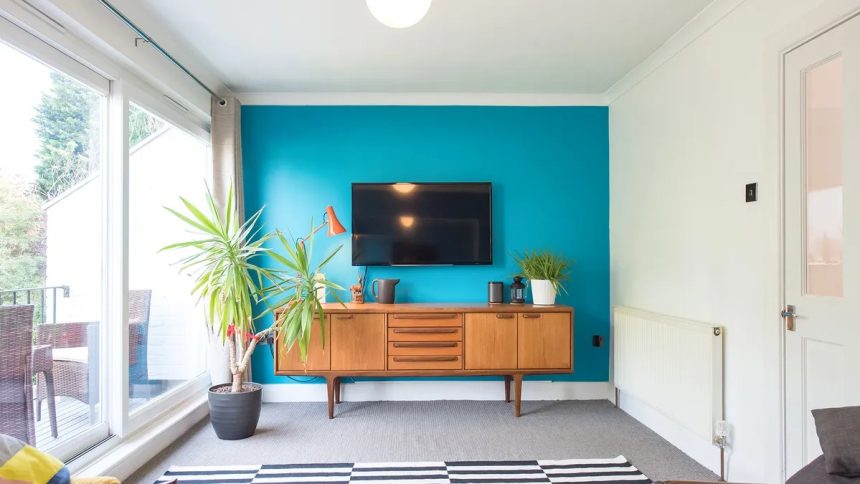If your TV room is filled with windows, lamps, or other light sources, you’re likely familiar with the frustrating reflections and glare they create on your TV screen. Even high-quality TVs with their mirror-like surfaces can’t escape these distracting patches of light. These reflections can range from mildly irritating to completely obstructing the picture. Unfortunately, matte-finish TVs are rare, so unless you prefer watching TV in a dark room, dealing with glare becomes an unavoidable challenge.
But fear not! If reducing the ambient light in your room isn’t an option or not enough, there are several tricks you can try to minimize or eliminate reflections and glare. The best part is, most of these tricks won’t cost you anything. So, don’t worry, you won’t have to live in darkness like a cave dweller unless, of course, you actually enjoy that. No judgment here!
Why does your TV screen reflect light?

The reflection of light on your TV screen is primarily due to the glossy nature of modern TVs. These glossy screens behave like mirrors, reflecting any light sources present in the room, such as windows or lamps. On the other hand, some older models and certain TVs have matte screens, which reduce the mirror-like reflections but still get affected by ambient light. With matte screens, the light energy is dispersed across the entire screen, resulting in reduced reflections but also making the black levels appear brighter and the overall image more washed out.
Regardless of the type of TV you have, if there is a light source in your room that can illuminate the TV screen, you will see its reflection, and it will impact the picture quality.
While there are adhesive antireflective coatings available for purchase online, it is generally advisable to avoid them. Applying such coatings to your TV screen may not guarantee improved image quality and could potentially be difficult to remove if you are dissatisfied with the results. Additionally, these coatings typically reduce reflections at the expense of overall image quality, similar to TVs that originally come with matte screens.
1. Reduce TV glare by turning off lights, but beware of eye strain
One way to reduce glare on your TV screen is by turning off the lights in the room. However, it’s important to be aware of potential eye strain that can occur when watching TV in complete darkness. Bright HDR (High Dynamic Range) TVs, in particular, can cause soreness in the eyes. Many people prefer to have some ambient light in the room to create a more comfortable viewing experience. Nevertheless, if you choose to watch TV in a dark room, you can adjust the TV’s brightness settings to minimize eye fatigue and reduce reflections.
For LCD TVs, there is usually a backlight control option in the user menu. On OLED TVs, you can adjust the “OLED Pixel Brightness.” By decreasing the brightness level, you can create a more relaxing image and improve the black levels of your TV. Keep in mind that when watching HDR content, TVs typically maximize brightness to enhance the picture quality.

2. Save your eyes: Put a lamp behind the TV to get rid of glare
If you prefer not to adjust your TV settings or invest in a projector and screen, another option to reduce glare and eye strain is to place a lamp behind the TV. This technique is known as bias lighting. By adding a light source behind the TV, you raise the ambient light level in the room, which can help alleviate eye fatigue without causing reflections on the screen.
When choosing a lamp for bias lighting, it’s essential to select a light that is as color-neutral as possible. Any color in the lamp can affect the color representation on the TV screen. For instance, a red light will make the TV display appear less red.
You have the choice of creating your own bias light setup or purchasing a pre-made one online. Keep in mind that in professional environments where individuals spend long hours looking at screens in dark rooms, such as movie and TV editors, bias lights are commonly used. When buying bias lights online, exercise caution as LED products may not always accurately match their claimed color. The color, or lack thereof, is crucial for achieving the desired effect.

3. Try tilting you TV screen or moving lamps around
If you’re dealing with reflections on your TV screen, there are a couple of solutions you can try:
- Wall Mount with Pivot or Tilt: Consider mounting your TV on a wall mount that offers pivoting or tilting capabilities. This way, when you notice reflections on the screen, you can adjust the TV’s position slightly to redirect the reflection elsewhere, making it less visible. However, keep in mind that LCD TVs generally have reduced picture quality when viewed off-axis or off-center. Tilting or pivoting the TV may result in some loss of picture quality.
- Adjusting Lamp Placement: Another option is to relocate the lamps or modify their positions to prevent direct reflection onto the TV screen. It’s possible that you’ve already tried this approach, but it’s worth experimenting with different lamp positions to find the best setup that minimizes reflections.
If you’re uncertain about where to place your TV for optimal viewing, you can refer to our guide on finding the ideal location. Just note that placing the TV above a fireplace is generally not recommended for an optimal viewing experience.

4. Get smart lamps and outlets to control your lighting without leaving the couch
If you want to have more convenient control over the lighting in your room without having to leave the couch, you can consider using smart lamps, outlets, and switches. These devices allow you to control individual lights or groups of lights and integrate them with voice assistants like Alexa, Google Assistant, or Siri. By connecting your lights to these smart systems, you can simply use voice commands, such as “Ceiling lights off,” to turn off the lights that are causing reflections, all while staying comfortably seated.
Additionally, you can explore the option of incorporating remote-controlled sun shades into your setup. These shades can be adjusted to control the amount of natural light entering the room, helping to minimize glare and reflections on the TV screen.
By utilizing these smart lighting solutions and remote-controlled sun shades, you can have greater control over the lighting in your room and reduce the impact of reflections on your TV viewing experience.

5. Put sun shades or blackout curtains on the windows
If you have a room with lots of windows and you’re dealing with excessive sunlight, it can be challenging to achieve optimal TV viewing conditions. Even with the brightest LCD TVs, having too much light in the room can impact picture quality.
In situations where light control is crucial, such as when using a projector, you can consider using sun shades or blackout curtains on your windows. Sun shades are designed to block out or filter sunlight, reducing glare and reflections on the TV screen. Blackout curtains, on the other hand, are made with materials that effectively block out light, creating a darker environment that is more conducive to TV viewing.
You can find sun shades or blackout curtains at home improvement stores or online retailers. They come in various sizes and styles to suit your preferences and can be an effective solution for controlling the amount of light entering your room and improving your TV viewing experience. While blackout curtains may be a bit more expensive than regular curtains, they can provide a significant reduction in sunlight and create a more immersive environment for your TV or projector setup.








